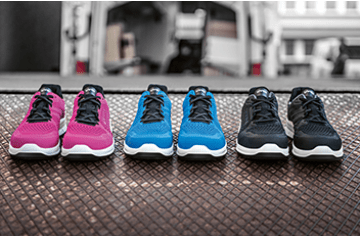
An anti-perforation sole, often described as a ‘steel sole’, ensures that sharp objects cannot pierce the shoe, skin or feet.
Do you need a steel or synthetic anti-perforation sole?
At the moment, there are two types of perforation-resistant sole for protective shoes, both of which fulfil the minimum requirements for perforation resistance.
It is important to know that both types are resistant to point-loading of 1100 N and so, in principle, you are protected against damaging your foot by standing on a nail.
Synthetic
A plastic anti-perforation sole is usually made of Kevlar. This is comfortable to wear and makes the sole very lightweight and flexible. This flexibility also ensures greater contact with the floor surface and reduces the risk of slipping and falling.
Kevlar is a woven structure. The perforation resistance is therefore more dependent on the shape of the sharp object or hazard (diameter, geometry, sharpness). With a very thin point and high loading, it is possible that the point could push through the fibres and damage the foot.
Kevlar, however, protects the entire sole area, compared to the guaranteed protection of around 85% with the steel variant.
Metal
Steel anti-perforation soles are heavier and less flexible than the synthetic variant. In the winter, a steel sole can also feel cold when you put your shoes on.
Metal is less dependent on the shape of the sharp object or hazard (diameter, geometry, sharpness), but due to the technical limitations of the shoes, the entire surface of the foot cannot be covered.

What is required of this type of sole?
The perforation resistance P and PL are measured using a nail, with a diameter of 4.5 mm, which is pushed against the sole of the shoe with a pressure equal to 1100 Newton (N). There is also the perforation resistance PS, whereby a nail with a diameter of three millimetres is used.
There are other specifications too:
- The forces must be greater than 1100 N if we want to refer to a shoe as S3 or S1P. With plastic and metal soles, the perforation point must not penetrate with pressure of 1100 N. Bear in mind that higher forces or thinner nails might increase the risk of perforation.
- The perforation resistant sole must be incorporated in such a way that it cannot be removed.
- The anti-perforation sole does not need to cover the entire surface. Space on the edges is required to secure the sole properly. In the middle, three holes are permitted for securing purposes.
- Anti-perforation soles must also pass through a flexibility test.
- Metal anti-perforation soles are also tested for corrosion.
- Synthetic or plastic soles are subject to a number of ageing tests: high temperatures, low temperatures, acid, alkali, fuel oil. After the ageing test, the sole must still pass the perforation test with 1100 Newtons.








